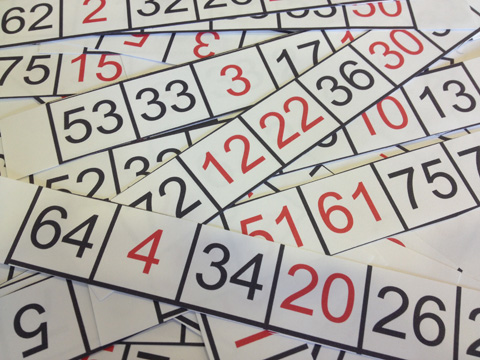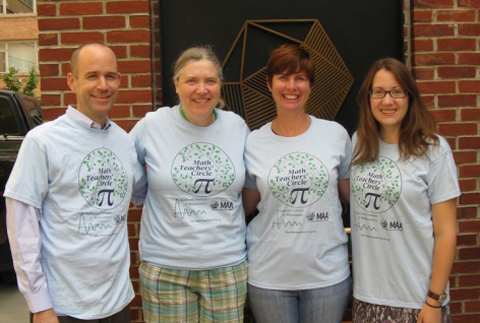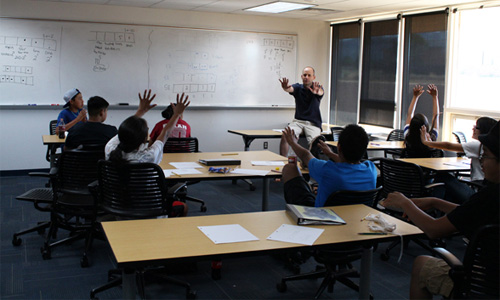Are math lovers the new underground?
In the former Soviet Union, students who wanted to learn more—at the time the Soviets were dictating what was allowable in terms of research and studies—gathered in kitchens and living rooms in small groups to do…math.
“Math circles,” as they were known, were “something that people could do in apartments, in communities and small groups without lab equipment,” says Ohio University’s Dr. Robert Klein. “So mathematicians got students together in their houses and apartments and engaged them in interesting mathematical problems in defiance of whatever the regime might say you can or cannot do. It really was an act of democracy, of subversion.”
So why are math circles popping up now in the United States, a free and open society? Is it in defiance of pop culture and peer pressure? Or a need to break out of the structured curriculum of the classroom? Or both?
“Of course we don’t have a dictatorial regime,” comments Klein, “but the growing desire for math circles reacts in some ways to the need for non-curricular mathematics—mathematics outside the classroom for engaging open-ended problems and focusing on problem solving.”
But in the United States, even the math circles had rules and regulations. The circles were for the children. Parents and teachers had to sit at the back of the room and observe, but they weren’t allowed to participate.
“‘Why should the kids have all the fun? We want one, too,’ said a teacher to a group of people at the American Institute for Mathematics a few years ago. And math circles just for teachers were born,” says Klein, Associate Professor of Mathematics in Ohio University’s College of Arts & Sciences. “It’s a chance for them to rediscover what they loved about doing mathematics in the first place.”
Summer Immersion—Math Circles for Teachers
Word spread rapidly among the Athens County’s K-12 math teachers—a math circle just for them was coming to Athens. Even math teachers at the other end of the state—Toledo—got the word. Twenty-three of them have signed up for the plunge—a four-day summer immersion in mathematics.
“This messages of ‘why should kids have all the fun?’ and ‘let’s group professional development in content instead of in pedagogy’ seem to be appealing ones,” says Klein. On the immersion agenda: the locker problem, MathMagic, number bracelets, operation cookie jar, exploding dots, and conversations with Dr. Judith Covington, a national teaching award-winning Associate Professor of Mathematics from Louisiana State University Shreveport.
The SouthEast Ohio Math Teachers’ Circle meets July 22-25 in Athens at the Holiday Inn. The group will continue meeting throughout the year to do math and is participating in a national study of whether math teachers’ circles increase content knowledge in key areas. At the start of the summer program, the teachers will take a Learning Mathematics for Teachers instrument.
Example Activity—Liar’s Bingo
At the spring kickoff meeting of the circle, Klein presented participants with hundreds of strips of paper with six red and black numbers and asked them what patterns they noticed across the various strips. “They generated a huge list of patterns they recognized. The human brain does a great job of recognizing patterns. Then we played liar’s bingo. I asked them to look at the strips of colored numbers and to read the colors from left to right, but to lie to me on one of the colors. Then I would tell them number they lied about.”
There is a pattern to the number strips. “They challenge me, and eventually they figure it out. About an hour and a half and we figure out what’s going on here, what the technique is,” says Klein. “The underlying mathematics in this case deals with binary representations, and so we use that as an engaging spring board to then talk about coins in ‘two land,” where we only have currency in denominations of 1s, 2s, 4s, 8s, instead of 1s, 10s, 100s. And if you could only pay with one of each, or two of each, what patterns do you notice? It’s just a morning spent talking binary.”
Klein notes that good activities for teachers’ circles are “very low entry but very high threshold. One of the goals is to take math as mathematicians see it—those practices and those ways of thinking—and bringing that to K-12 teachers…really in the sense of this way of thinking. This type of problem solving is what I like to do, and let me share that with you,” says Klein.
A Higher Ed/ K-12 Collaboration
Klein’s collaborators on the teachers’ circle are area middle school and elementary teachers. Funding comes from several sources, including on Ohio Board of Regents Improving Teacher Quality grant for the summer immersion experience.
Nina Sudnick and Susan Matters teach fourth grade at West Elementary in Athens. Katie Hendrickson, who teaches seventh-grade mathematics at Athens Middle School, submitted the original grant and recruited the others to the project. The group won a grant from the Mathematical Association of America and the American Institute of Mathematics to go to Washington, D.C., for a week last summer to learn how to facilitate a math teachers’ circle.
Funding for the circle comes from several sources, including a $36,000 Ohio Board of Regents Improving Teacher Quality grant for the summer immersion experience. Klein noted that the board was “surprised by what we are able to deliver on a shoestring.”
Other contributors include The Stevens Literacy Center, Math for America, The American Institute of Mathematics (AIM), The National Council of Teachers of Mathematics (NCTM), The Ohio University Office of Research and Sponsored Programs, and the Athens Area Chamber of Commerce.
Next—an International Circle? Is Math Addictive?
Klein also is thinking about creating a math circle for students with an international twist. He is brainstorming with Javier Ronquillo, a graduate student from Guatemala with extensive experience working with International Mathematics Olympiad teams. Ronquillo would co-facilitate sessions in Ohio but also work to translate activities into Spanish and set up a sister circle in Quetzaltenango, Guatemala.
In March, Klein attended a “Circle on the Road” in Puerto Rico under the umbrella of the National Association of Math Circles, in which he shared ideas with math circle and math teacher circle leaders from around the United States. The Circle on the Road concluded with the Julia Robinson Mathematics Festival, a day of activities with Puerto Rican teachers and students.
Klein will be on sabbatical in Fall 2013, continuing his research on rural issues in mathematics education. Another lingering question on his mind: “Could we get kids addicted to mathematics? And if so, how? My thought is that we don’t often think of learning in K-12 classrooms as a protracted process where kids are ready for certain things at certain times. We think about that in terms of content but not in terms of mental state necessarily.” Klein is pondering turning the notion of addiction on its head—creating an addiction rather than curing it.





















Comments